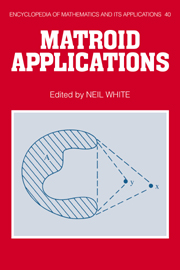Book contents
- Frontmatter
- Contents
- List of Contributors
- Preface
- 1 Matroids and Rigid Structures
- 2 Perfect Matroid Designs
- 3 Infinite Matroids
- 4 Matroidal Families of Graphs
- 5 Algebraic Aspects of Partition Lattices
- 6 The Tutte Polynomial and Its Applications
- 7 Homology and Shellability of Matroids and Geometric Lattices
- 8 Introduction to Greedoids
- Index
4 - Matroidal Families of Graphs
Published online by Cambridge University Press: 19 March 2010
- Frontmatter
- Contents
- List of Contributors
- Preface
- 1 Matroids and Rigid Structures
- 2 Perfect Matroid Designs
- 3 Infinite Matroids
- 4 Matroidal Families of Graphs
- 5 Algebraic Aspects of Partition Lattices
- 6 The Tutte Polynomial and Its Applications
- 7 Homology and Shellability of Matroids and Geometric Lattices
- 8 Introduction to Greedoids
- Index
Summary
Introduction
The connections between graph theory and matroid theory can be traced back to the study of graphic matroids, which were introduced by Whitney (1935) and have been extensively investigated (see Chapters 1, 2, and 6 of White, 1986). We recall that a matroid is graphic if it is isomorphic to the polygon matroid of some graph.
In this chapter we present some recent results that give a new setting to the relations between graphs and matroids. In the light of this setting, the polygon matroid appears as the simplest and best known object among an uncountably infinite collection of similar objects.
The fundamental concept that we want to introduce is the concept of a ‘matroidal family of graphs’. The precise definition is given below. According to this definition, the collection of all polygons is a matroidal family of graphs, the simplest among the non-trivial ones. Another example of a matroidal family of graphs is the collection of all bicycles, where a bicycle is a connected graph with two independent cycles and no vertex of degree less than two, that is to say, a bicycle is a graph homeomorphic to one of the graphs J00, J0.0, or J0.0 pictured in Figure 4.1.
As we shall see, there are uncountably many matroidal families of graphs; the subject is virtually unexplored and this chapter is just a brief introduction to this fascinating new field.
- Type
- Chapter
- Information
- Matroid Applications , pp. 91 - 105Publisher: Cambridge University PressPrint publication year: 1992
- 1
- Cited by



